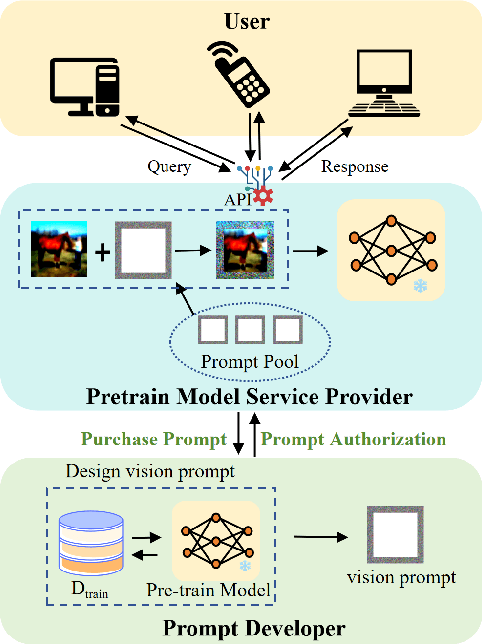Hongyang Yan
Are You Copying My Prompt? Protecting the Copyright of Vision Prompt for VPaaS via Watermark
May 24, 2024



Abstract:Visual Prompt Learning (VPL) differs from traditional fine-tuning methods in reducing significant resource consumption by avoiding updating pre-trained model parameters. Instead, it focuses on learning an input perturbation, a visual prompt, added to downstream task data for making predictions. Since learning generalizable prompts requires expert design and creation, which is technically demanding and time-consuming in the optimization process, developers of Visual Prompts as a Service (VPaaS) have emerged. These developers profit by providing well-crafted prompts to authorized customers. However, a significant drawback is that prompts can be easily copied and redistributed, threatening the intellectual property of VPaaS developers. Hence, there is an urgent need for technology to protect the rights of VPaaS developers. To this end, we present a method named \textbf{WVPrompt} that employs visual prompt watermarking in a black-box way. WVPrompt consists of two parts: prompt watermarking and prompt verification. Specifically, it utilizes a poison-only backdoor attack method to embed a watermark into the prompt and then employs a hypothesis-testing approach for remote verification of prompt ownership. Extensive experiments have been conducted on three well-known benchmark datasets using three popular pre-trained models: RN50, BIT-M, and Instagram. The experimental results demonstrate that WVPrompt is efficient, harmless, and robust to various adversarial operations.
Auto-Focus Contrastive Learning for Image Manipulation Detection
Nov 20, 2022



Abstract:Generally, current image manipulation detection models are simply built on manipulation traces. However, we argue that those models achieve sub-optimal detection performance as it tends to: 1) distinguish the manipulation traces from a lot of noisy information within the entire image, and 2) ignore the trace relations among the pixels of each manipulated region and its surroundings. To overcome these limitations, we propose an Auto-Focus Contrastive Learning (AF-CL) network for image manipulation detection. It contains two main ideas, i.e., multi-scale view generation (MSVG) and trace relation modeling (TRM). Specifically, MSVG aims to generate a pair of views, each of which contains the manipulated region and its surroundings at a different scale, while TRM plays a role in modeling the trace relations among the pixels of each manipulated region and its surroundings for learning the discriminative representation. After learning the AF-CL network by minimizing the distance between the representations of corresponding views, the learned network is able to automatically focus on the manipulated region and its surroundings and sufficiently explore their trace relations for accurate manipulation detection. Extensive experiments demonstrate that, compared to the state-of-the-arts, AF-CL provides significant performance improvements, i.e., up to 2.5%, 7.5%, and 0.8% F1 score, on CAISA, NIST, and Coverage datasets, respectively.
 Add to Chrome
Add to Chrome Add to Firefox
Add to Firefox Add to Edge
Add to Edge